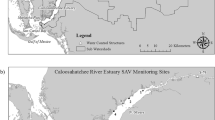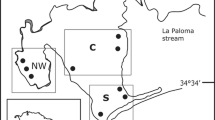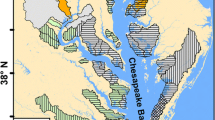Abstract
Submersed aquatic vegetation (SAV) communities have undergone declines worldwide, exposing them to invasions from non-native species. Over the past decade, the invasive species Hydrilla verticillata has been documented in several tributaries of the lower Chesapeake Bay, Virginia. We used annual aerial mapping surveys from 1998 to 2007, integrated with spatial analyses of water quality data, to analyze the patterns and rates of change of a H. verticillata-dominated SAV community and relate them to varying salinity and light conditions. Periods of declining SAV coverage corresponded to periods where salinities exceeded 7 and early growing season (April to May) Secchi depths were <0.4 m. Increases were driven by the expansion of H. verticillata along with several other species into the upper estuary, where some areas experienced an 80% increase in cover. Field investigations revealed H. verticillata dominance to be limited to the upper estuary where total suspended solid concentrations during the early growing season were <15 mg l−1 and salinity remained <3. The effect of poor early growing season water clarity on annual SAV growth highlights the importance of water quality during this critical life stage. Periods of low clarity combined with periodic salinity intrusions may limit the dominance of H. verticillata in these types of estuarine systems. This study shows the importance of the use of these types of biologically relevant episodic events to supplement seasonal habitat requirements and also provides evidence for the potential important role of invasive species in SAV community recovery.







Similar content being viewed by others
References
Altman, S., and R.B. Whitlatch. 2007. Effects of small-scale disturbance on invasion success in marine communities. Journal of Experimental Marine Biology and Ecology 342: 15–29.
Batiuk, R.A., R.J. Orth, K.A. Moore, W.C. Dennison, J.C. Stevenson, L.W. Staver, V. Carter, N.B. Rybicki, R.E. Hickman, S. Kollar, S. Bieber, and P. Heasly. 1992. Chesapeake Bay submerged aquatic vegetation habitat requirements and restoration targets: A technical synthesis. Annapolis: US EPA, Chesapeake Bay Program. 170 pp.
Batiuk, R.A., P. Bergstrom, M. Kemp, E. Koch, L. Murray, J.C. Stevenson, R. Bartleson, V. Carter, N. Rybicki, J.M. Landwehr, C. Gallegos, L. Karrh, M. Naylor, D. Wilcox, K.A. Moore, S. Ailstock, and M. Teichberg. 2000. Chesapeake Bay submerged aquatic vegetation water quality and habitat-based requirements and restoration targets: A second technical synthesis. Annapolis: US EPA, Chesapeake Bay Program. 220 pp.
Carter, V., and N. Rybicki. 1986. Resurgence of submersed aquatic macrophytes in the tidal Potomac River, Maryland, Virginia, and the District of Columbia. Estuaries 9(4): 368–375.
Carter, V., and N.B. Rybicki. 1990. Light attenuation and submersed macrophyte distribution in the tidal Potomac river and estuary. Estuaries 13(4): 441–452.
Carter, V., N.B. Rybicki, J.M. Landwehr, and M. Turtora. 1994. Role of weather and water quality in population dynamics of submersed macrophytes in the tidal Potomac River. Estuaries 17(2): 417–426.
Chadwell, T.B. 2008. Effects of pre-existing submersed vegetation and propagule pressure on the invasion success of Hydrilla verticillata. Journal of Applied Ecology 45: 515–523.
Chambers, P.A., J.W. Barko, and C.S. Smith. 1993. Evaluation of invasions and declines of submersed aquatic macrophytes. Journal of Aquatic Plant Management 31: 218–220.
Cho, H.J., and M.A. Poirrier. 2005. A model to estimate potential submersed aquatic vegetation habitat based on studies in Lake Pontchartrain, Louisiana. Restoration Ecology 13(4): 623–629.
Dennison, W.C., R.J. Orth, K.A. Moore, J.C. Stevenson, V. Carter, S. Kollar, P.W. Bergstrom, and R.A. Batiuk. 1993. Assessing water quality with submersed aquatic vegetation. BioScience 43(2): 86–94.
Dobberfuhl, D.R. 2007. Light limiting thresholds for submerged aquatic vegetation in a blackwater river. Aquatic Botany 86: 346–352.
Erftemeijer, P.L.A., and E.W. Koch. 2001. Sediment geology methods for seagrass habitat. In Global seagrass research methods, ed. F.T. Short and R.G. Coles, 345–367. Amsterdam: Elsevier Science.
Frazer, T.K., S.K. Notestein, C.A. Jacoby, C.J. Littles, S.R. Keller, and R.A. Swett. 2006. Effects of storm-induced salinity changes on submersed aquatic vegetation in Kings Bay, Florida. Estuaries and Coasts 29(6A): 943–953.
Haller, W.T., D.L. Sutton, and W.C. Barlowe. 1974. Effects of salinity on growth of several aquatic macrophytes. Ecology 55: 891–894.
Hobbs, R.J., and L.F. Huenneke. 1992. Disturbance, diversity, and invasion: Implications for conservation. Conservation Biology 6(3): 324–337.
Hofstra, D.E., J. Clayton, J.D. Green, and M. Auger. 1999. Competitive performance of Hydrilla verticillata in New Zealand. Aquatic Botany 63: 305–324.
Kemp, W.M., R. Batiuk, R. Bartleson, P. Bergstrom, V. Carter, C.L. Gallegos, W. Hunley, L. Karrh, E.W. Koch, J.M. Landwehr, K.A. Moore, L. Murray, M. Naylor, N.B. Rybicki, J.C. Stevenson, and D.J. Wilcox. 2004. Habitat requirements for submerged aquatic vegetation in Chesapeake Bay: Water quality, light regime, and physical–chemical factors. Estuaries 27(3): 363–377.
Koch, E.W. 2001. Beyond light: Physical, geological, and geochemical parameters as possible submersed aquatic vegetation habitat requirements. Estuaries 24(1): 1–17.
Korschgen, C.E., W.L. Green, and K.P. Kenow. 1997. Effects of irradiance on growth and winter bud production by Vallisneria americana and consequences to its abundance and distribution. Aquatic Botany 58: 1–9.
Liao, N. 2001. Determination of ammonia in brackish or seawater by flow injection analysis. QuikChem Method 31-107-06-1-B. Milwaukee: Lachat Instruments. Revised 2002.
Minchinton, T.E. 2002. Disturbance by wrack facilitates spread of Phragmites australis in a coastal marsh. Journal of Experimental Marine Biology and Ecology 281: 89–107.
Moore, K.A., R.L. Wetzel, and R.J. Orth. 1997. Seasonal pulses of turbidity and their relations to eelgrass (Zostera marina L.) survival in an estuary. Journal of Experimental Marine Biology and Ecology 215: 115–134.
Moore, K.A., D. J. Wilcox, R. J. Orth, and E. Bailey. 1999. Analysis of historical distribution of submerged aquatic vegetation (SAV) in the James River. Special Report N. 355 in Applied Marine Science and Ocean Engineering, the Virginia Institute of Marine Science, Gloucester Point, VA.
Moore, K.A., R.J. Orth, and D.J. Wilcox. 2009. Assessment of the abundance of submersed aquatic vegetation (SAV) communities in the Chesapeake Bay and its use in SAV management. In Remote sensing and geospatial technologies for coastal ecosystem assessment and management, Lecture Notes in Geoinformation and Cartography, ed. X. Yang, 233–257. Berlin: Springer.
Orth, R.J., and K.A. Moore. 1984. Distribution and abundance of submerged aquatic vegetation in Chesapeake Bay: An historical perspective. Estuaries 7: 531–540.
Orth, R.J., K.A. Moore, and H.H. Gordon. 1979. Distribution and abundance of submerged aquatic vegetation in the lower Chesapeake Bay. Chesapeake Bay Program Technical Report, 199. Annapolis: US EPA.
Orth, R.J., D.J. Wilcox, L.S. Nagey, J.R. Whiting, and J.R. Fishman. 2001. 2000 distribution of submerged aquatic vegetation in Chesapeake Bay and coastal bays. Special Scientific Report #142. Gloucester Point: Virginia Institute of Marine Science.
Orth, R.J., T.J.B. Carruthers, W.C. Dennison, C.M. Duarte, J.W. Fourqurean, K.L. Heck Jr., A.R. Hughes, G.A. Kendrick, W.J. Kenworthy, S. Olyarnik, F.T. Short, M. Waycott, and S.L. Williams. 2006. A global crisis for seagrass ecosystems. BioScience 56(12): 987–996.
Orth, R.J., D. J. Wilcox, J. R. Whiting, L. S. Nagey, A.L. Owens, and A.K. Kenne. 2008. 2007 distribution of submerged aquatic vegetation in Chesapeake Bay and coastal bays. Final Report U.S .E.P.A. Virginia Institute of Marine Science Special Scientific Report #151.
Orth, R.J., M.R. Williams, S.R. Marion, D.J. Wilcox, T.J.B. Carruthers, K.A. Moore, W.M. Kemp, W.C. Dennison, N. Rybicki, P. Bergstrom, and R.A. Batiuk. 2010. Long-term trends in submersed aquatic vegetation (SAV) in Chesapeake Bay, USA, related to water quality. Estuaries and Coasts 33(5): 1144–1163.
Rodriguez, L.F. 2006. Can invasive species facilitate native species? Evidence of how, when, and why these impacts occur. Biological Invasions 8: 927–939.
Rybicki, N.B., and V. Carter. 2002. Light and temperature effects on the growth of wild celery and Hydrilla. Journal of Aquatic Plant Management 40: 92–99.
Rybicki, N.B., and J.M. Landwehr. 2007. Long-term changes in abundance and diversity of macrophyte and waterfowl populations in an estuary with exotic macrophytes and improving water quality. Limnology and Oceanography 52(3): 1195–1207.
Sand-Jensen, K., T. Riis, O. Vestergaard, and S.E. Larsen. 2000. Macrophyte decline in Danish lakes and streams over the past 100 years. Journal of Ecology 88: 1030–1040.
Scheffer, M., S. Carpenter, J.A. Foley, C. Folke, and B. Walker. 2001. Catastrophic shifts in ecosystems. Nature 413: 591–596.
Shoaf, W.T., and B.W. Lium. 1976. Improved extraction of chlorophyll a and b from algae using dimethyl sulfoxide. Limnology and Oceanography 21: 926–928.
Sousa, W.T.Z., S.M. Thomaz, and K.J. Murphy. 2010. Response of native Egeria najas Planch. and invasive Hydrilla verticillata (L.f.) Royle to altered hydroecological regime in a subtropical river. Aquatic Botany 92: 40–48.
Steward, K.K., and T.K. Van. 1987. Comparative studies of monoecious and dioecious Hydrilla verticillata biotypes. Weed Science 35: 204–210.
Steward, K.K., T.K. Van, V. Carter, and A.H. Pieterse. 1984. Hydrilla invades Washington D.C. and the Potomac. American Journal of Botany 71(1): 162–163.
Syphard, A.D., and M.W. Garcia. 2001. Human and beaver-induced wetland changes in the Chickahominy River watershed from 1953 to 1994. Wetlands 21(3): 342–353.
Twilley, R.R., and J.W. Barko. 1990. The growth of submersed macrophytes under experimental salinity and light conditions. Estuaries 13(3): 311–321.
U.S. Environmental Protection Agency. 2008. Ambient water quality criteria for dissolved oxygen, water clarity and chlorophyll a for the Chesapeake Bay and its tidal tributaries—2008 addendum. EPA 903-R-08-001. Annapolis: Region III Chesapeake Bay Program Office.
Virginia Institute of Marine Science Nutrient Analysis Laboratory Procedure Manual. Orthophosphate procedure, Revision No. 3, 1991.
Ward, L.G., W.M. Kemp, and W.R. Boynton. 1984. The influence of waves and seagrass communities on suspended particulates in an estuarine embayment. Marine Geology 59: 85–103.
Waycott, M., C.M. Duarte, T.J.B. Carruthers, R.J. Orth, W.C. Dennison, S. Olyarnik, A. Calladine, J.W. Fourqurean, K.L. Heck Jr., A.R. Hughes, G.A. Kendrick, W.J. Kenworthy, F.T. Short, and S.L. Williams. 2009. Accelerating loss of seagrass across the globe threatens coastal ecosystems. Proceedings of the National Academy of Sciences 106(30): 12377–12381.
Yozzo, D.J., and D.E. Smith. 1995. Seasonality, abundance, and microhabitat distribution of meiofauna from a Chickahominy River, Virginia tidal freshwater marsh. Hydrobiologia 310: 197–206.
Author information
Authors and Affiliations
Corresponding author
Rights and permissions
About this article
Cite this article
Shields, E.C., Moore, K.A. & Parrish, D.B. Influences of Salinity and Light Availability on Abundance and Distribution of Tidal Freshwater and Oligohaline Submersed Aquatic Vegetation. Estuaries and Coasts 35, 515–526 (2012). https://doi.org/10.1007/s12237-011-9460-0
Received:
Revised:
Accepted:
Published:
Issue Date:
DOI: https://doi.org/10.1007/s12237-011-9460-0




